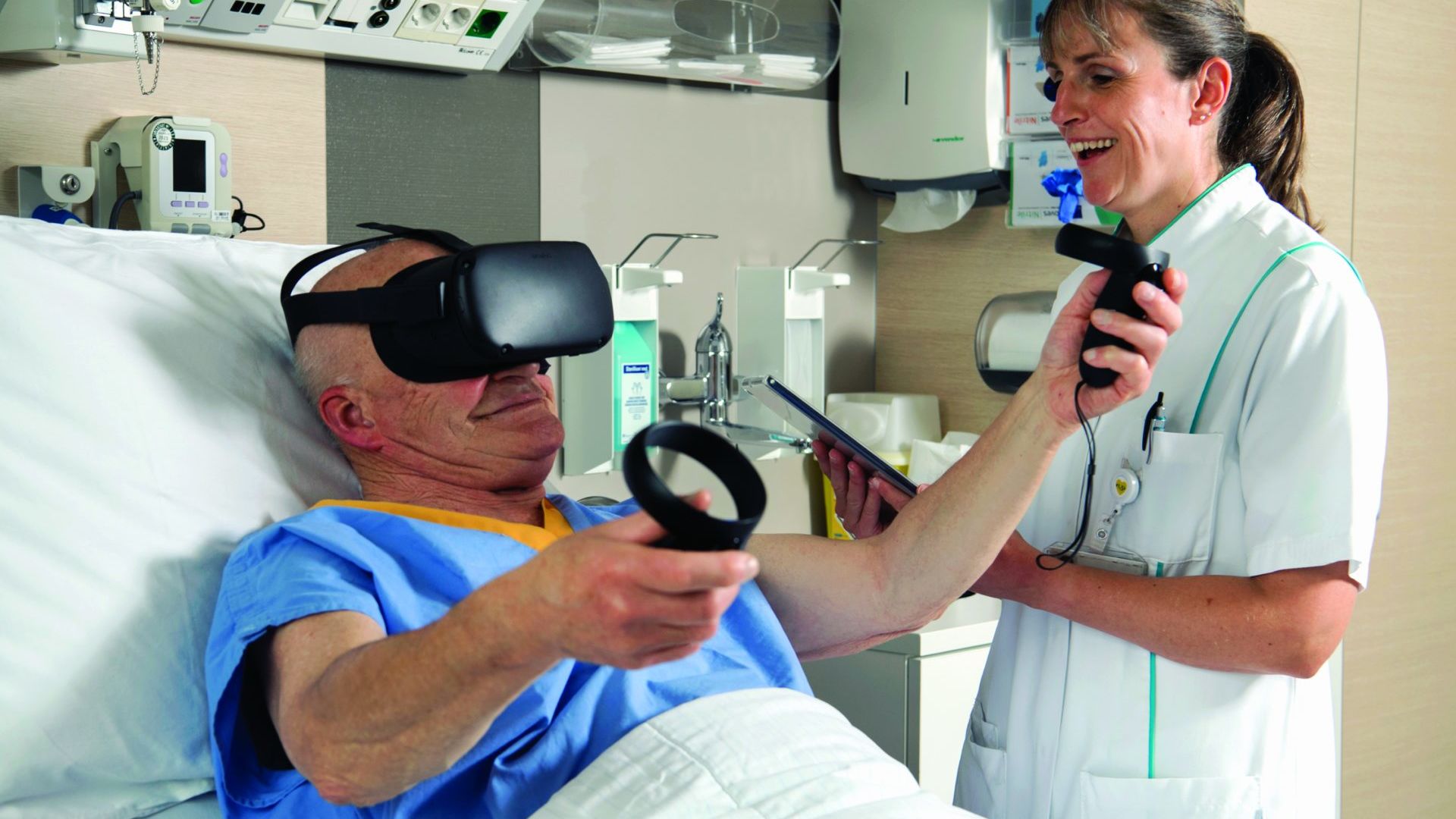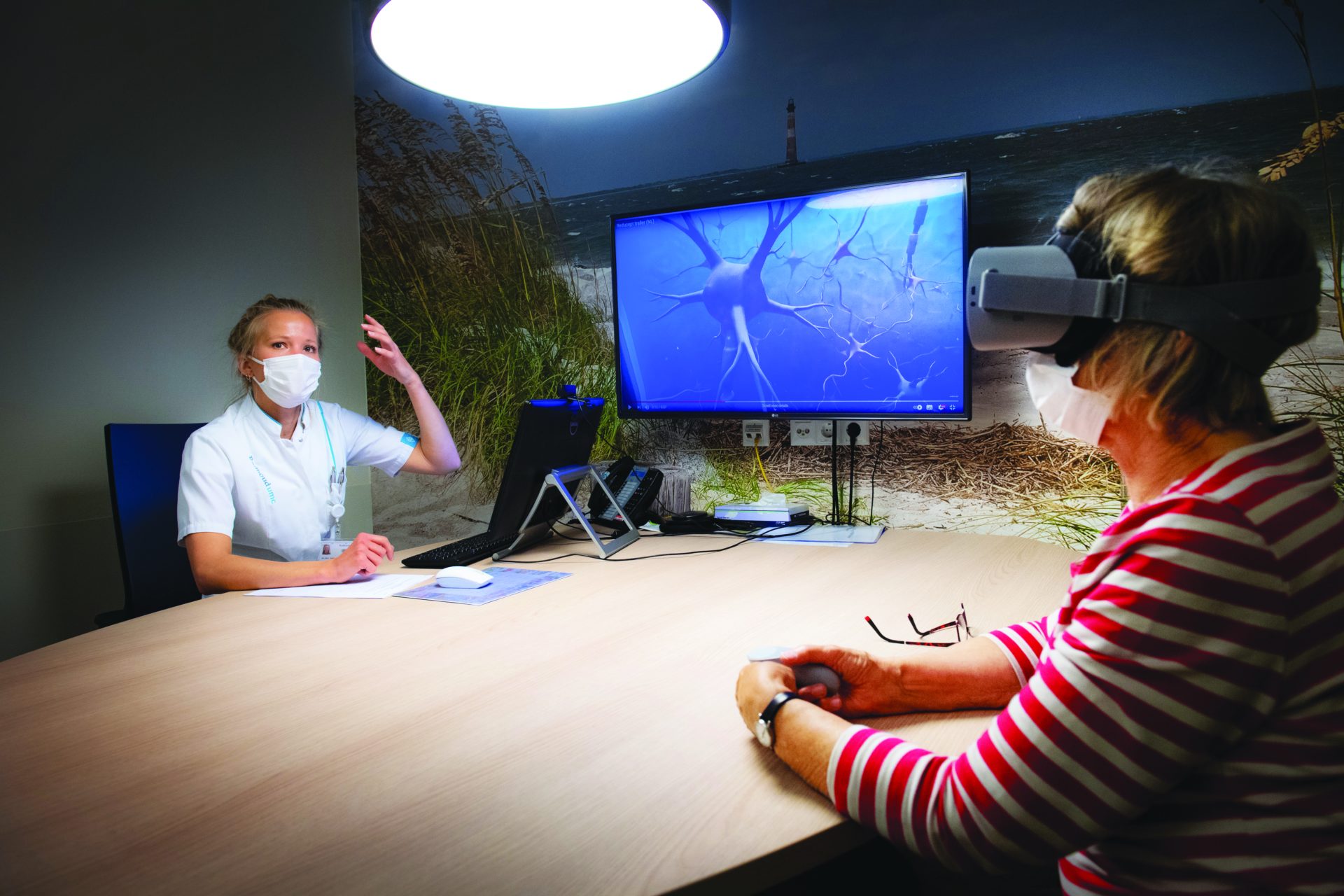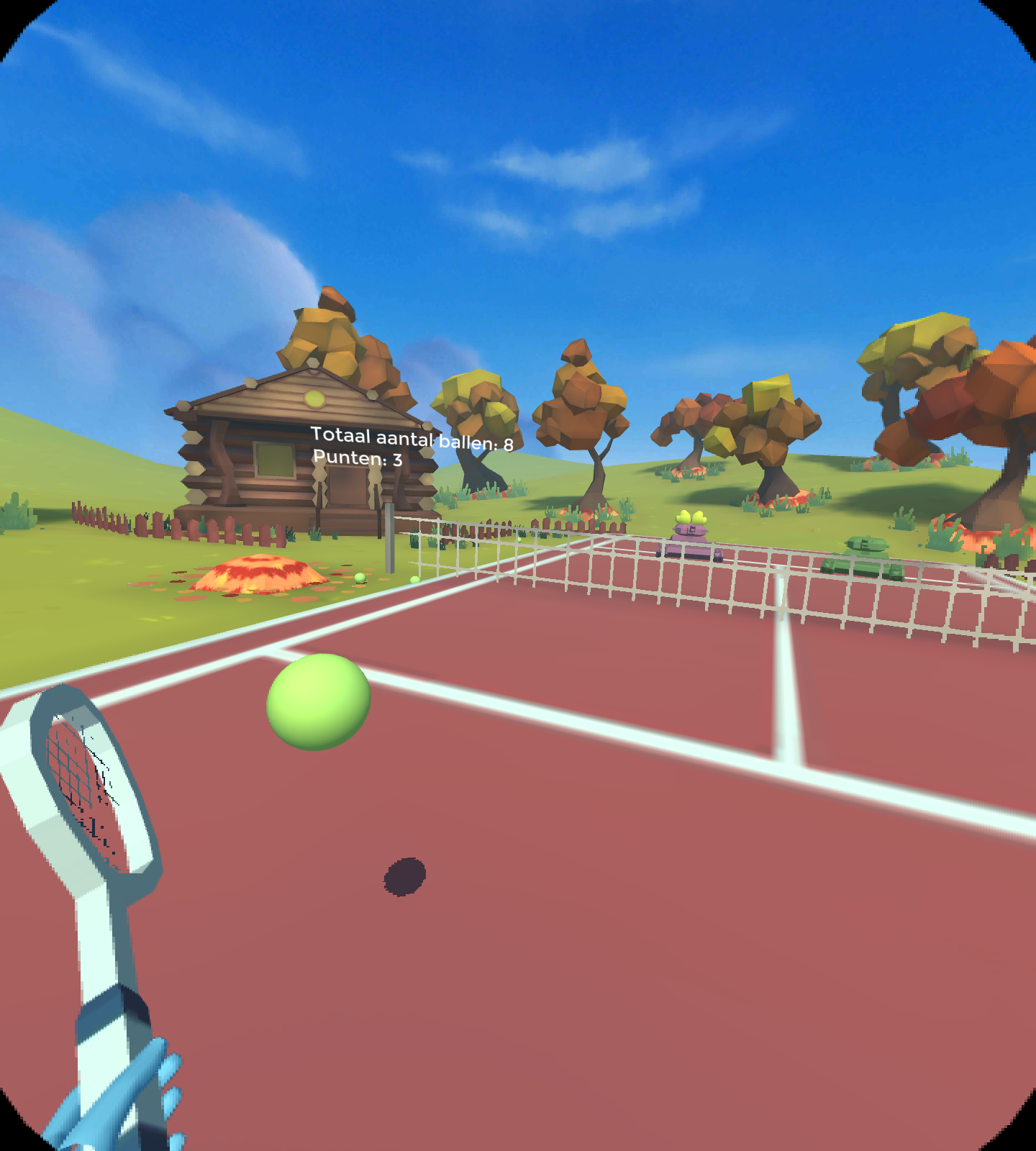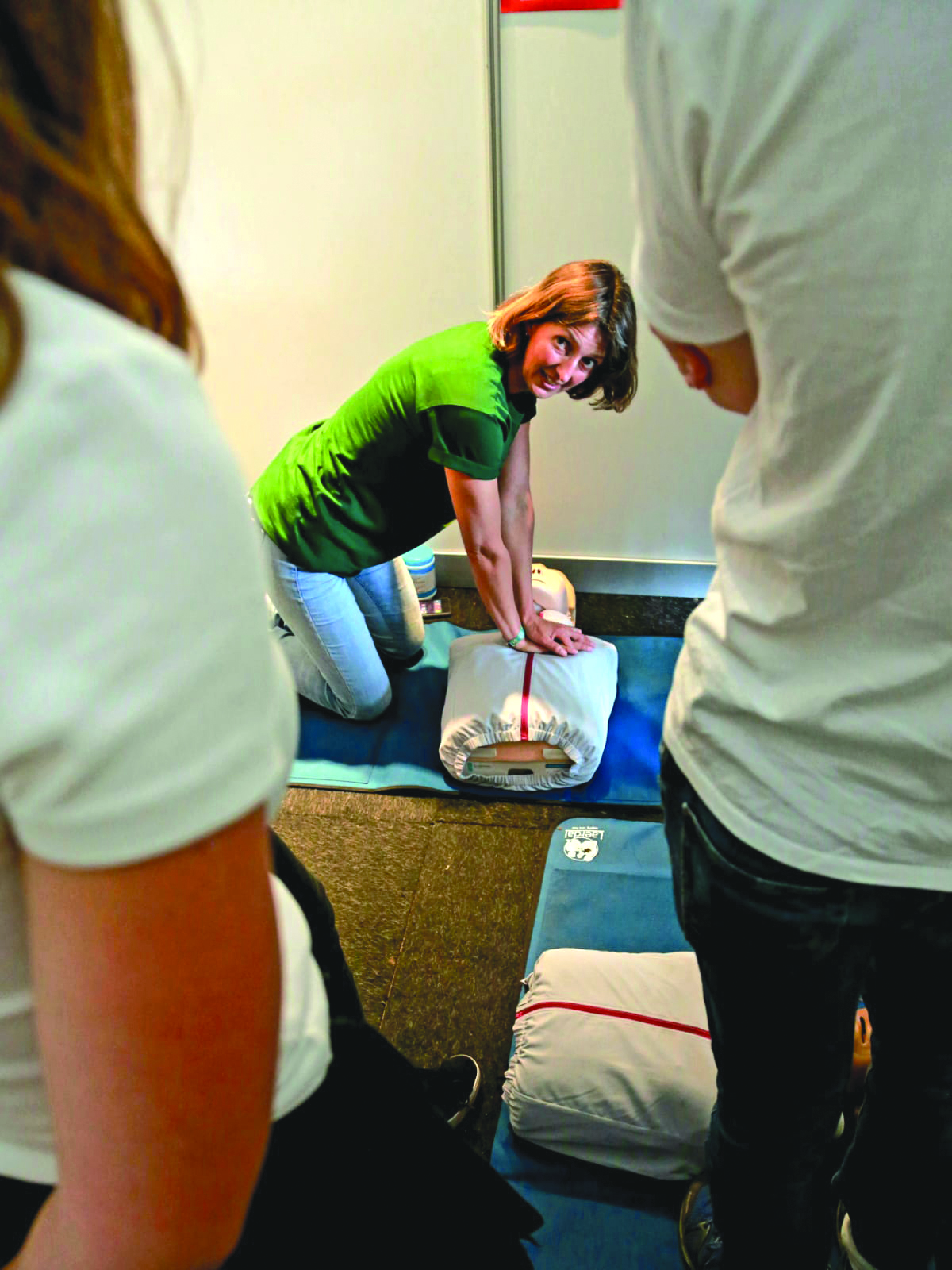Managing pain with a pair of VR glasses
-
 Photo: Radboudumc
Photo: Radboudumc
Virtual reality as replacement for pain killers? At Radboudumc, researchers study how VR can help patients cope with acute and chronic pain. ‘Virtual reality has long moved past the innovation phase. Its effectiveness is a given.’
I’m sitting in the cockpit of a space ship. Except this ship is not travelling through space, but through the nerves of the human body. Suddenly some red cloud-like ‘creatures’ glide over a nerve to my left. I shoot them down by looking at them.
Boom! Gone.
Now new creatures appear to my right. They keep coming. I keep staring them into oblivion. In the meantime, a friendly female voice informs me that I’ve made good progress and that I can imagine this exercise when I experience pain in real life. Because that is what the red creatures represent: pain. I’m playing a VR game for patients with chronic pain.
The video game is not intended to eliminate pain, but to give patients more control over their pain, explains Radboudumc surgeon Harry van Goor. The treatment focuses on learning to cope with pain symptoms that won’t go away. ‘If it works, people often experience less pain as a result.’
‘In some situations, VR is more effective than pills’
The Nijmegen physician is carrying out a number of studies on VR in healthcare and advocates the use of more technology in practice, both in the hospital and at home. ‘In some situations, VR has proven to be more effective than for example pills, with fewer side effects. Especially when it comes to coping with pain, this effect has been shown in multiple studies. But for some reason, the jump to application in practice is slow to happen.’
Acute pain
Van Goor first became interested in this topic some three years ago, after attending a conference on it. At this conference, he met the US gastroenterologist Brennan Spiegel, an international pioneer in the field of VR, with whom he is still in contact.
Spiegel has different types of patients watch videos or play VR games, from women with contractions to children who are afraid of having an IV put in. In a 2019 study, 60 hospital patients from different departments were given VR glasses and invited to use them whenever they liked. They were also asked a few times a day to indicate how much pain they experienced on a scale of 1 to 10. In the VR group, the pain score during the test period dropped by 1.17 points more than in a control group that was only offered relaxing TV programmes.
Together with a number of surgery departments at Radboudumc and the Sint Maartenskliniek, Van Goor launched a comparable study on post-surgery pain management. The researchers measured pain relief and medication, but their main goal was to explore how patients used the VR glasses: what kind of patient reached out for the glasses in hospital, and how often did they do so? The researchers hope to publish the results soon, but one striking discovery is that approximately 50% of the test subjects used the glasses more often than the indicated minimum of 20 to 30 minutes a day, some up to 2.5 hours a day. Age and gender played no role in this context. This is an important factor to take into account in VR treatment, because clearly you don’t want patients to obsessively game away their pain and tire themselves out.
For acute pain, the idea is that VR provides distraction, and therefore direct pain relief: in the virtual world, the brain forgets for a while the painful surgery wound. When it was found that this also worked for burns and phantom pains, researchers started studying the use of VR for chronic pain. In cases like these, distraction alone is not enough, and the treatment is more of a virtual variation on cognitive behaviour therapy.
It works for some people, as shown by a study conducted by Radboudumc in collaboration with the Rijnstate Hospital in Arnhem. In a randomised study, 24 patients played a VR game for six weeks. 75% of them experienced a positive effect in terms of coping with everyday pain. Van Goor: ‘There were also people who said: It’s not my thing. Which is just as interesting, since we also want to understand why and for whom it doesn’t work.’ In this specific study, this was partially to do with expectations, thinks Van Goor. ‘The study took place during a time when patients were waiting for an appointment with an anaesthesiologist for treatment for their back pain, a treatment the patients had high expectations of.’ Perhaps higher than their expectations of the VR game they were invited to play in the meantime. A similar study is currently being performed with patients with chronic abdominal pain, for whom there are no alternative treatment options. ‘We see that this group has more positive expectations of VR.’
Abdominal pain study
One of the patients from the abdominal pain study is Gemmy, who like the other participants developed pain from adhesions: scar tissue that develops in the abdomen after an operation. Adhesions can be surgically removed, but for some patients this is too dangerous or ineffective. We met Gemmy in late April, when she came by to return the VR glasses she had been given a month earlier. The exit interview with research physician Masja Toneman revealed that Gemmy was disappointed by the experiment. ‘The images were too intense for me, there were too many stimuli.’ This made her nauseous and dizzy and after a few days she decided to stop. Most people have no trouble navigating the virtual world, but a small minority struggles with it, as apparent from other studies. However, both Toneman and Van Goor emphasise that this is truly the only potential side-effect. Sometimes the nausea diminishes over time. Also, anyone can learn to use these devices, without any prior experience of video games or digital knowledge.

The next question is, of course, whether it helps. The pilot study only involved ten participants, a too small sample for measuring effectiveness, but a follow-up study is due to start shortly. With more test subjects, and possibly a longer treatment period or the involvement of a psychologist. Toneman: ‘As a doctor, I can of course explain how this treatment works, but a psychologist or psychotherapist could guide the patients much better.’
Glasses on loan
Ultimately the researchers hope to convince health insurance companies that VR is a promising form of therapy. Because money is still an important obstacle: a good-quality VR set is expensive and often not reimbursed. Having said that, Van Goor is a little tired of people still seeing VR technology as a promising innovation that has to prove itself. He doesn’t even like to refer to it as an innovation. ‘It’s long past the innovation phase; there is so much evidence of the effectiveness of VR in treating conditions like pain, stress, and anxiety.’
At Radboudumc, he has therefore taken matters into his own hands by creating a VR helpdesk based in the surgery department. Soon hospital departments and partners will be able to contact the VR helpdesk to borrow equipment, including games. ‘There are different apps, for example for chronic pain, reducing anxiety, mindfulness or movement stimulation. Together with the relevant department, we decide which games may be suitable for their patients.’ The helpdesk will also function as a service and support desk where people can come for answers to their questions or help with technical problems.
In the meantime, the COVID-19 pandemic is providing an opportunity to use VR outside the hospital. When patients started reporting difficulties recovering from the virus, the Radboud team launched a practical study on post-COVID-19 rehabilitation in collaboration with HAN University of Applied Sciences and a number of physiotherapists. Van Goor: ‘Long Covid was new, so we didn’t yet know what games people could handle. What we did know was that patients with similar symptoms, for example after a case of Q fever, had suffered not only physical but also mental and cognitive damage.’ So, they offered the 40 participants VR games in all three domains, including memory assignments, breathing exercises, and different types of physical exercises. ‘For example, there was a game in which you had to hang fruit in the right tree or bush; it was all about bending down and stretching. At the same time, it also trained concentration and memory.’
‘You don’t want to tire patients out with all kinds of start-up issues’
Obviously you don’t need a virtual world to exercise your abs, but VR does provide extra motivation to actually do the exercises at home, thinks Van Goor. Another advantage is that a healthcare practitioner can check remotely what games a patient is playing and how often. ‘Practitioners can call to ask patients to play more or less often. In this study we saw that people sometimes overtrained and forgot the time. For example, one patient spent an entire hour playing a game, while the physiotherapist had advised him not to exceed half-an-hour.’
VR for pain relief
The rehabilitation study was not a randomised experiment with a control group, so it does not show how well VR works compared to other treatments. But the team learned a lot about how to practically and logistically offer VR treatment at home. Van Goor: ‘For example you don’t want to tire patients out with all kinds of start-up problems. Once they put on the glasses, they should be able to immediately access their personalised environment.’ One of the researchers on the team had to deliver the toolkits in person by car and call the participants from the hospital to help them get started. ‘If we want to scale up, we’ll have to figure out a different approach.’
In a larger follow-up study for which the team recently submitted a grant protocol, researchers want to supervise Long Covid patients entirely remotely. These patients wouldn’t be going to the physiotherapist or hospital at all anymore for follow-up interviews. This is in line with Van Goor’s ideas about the future of VR, with technology becoming a natural companion in our lives. In this imagined future, VR will have become so accessible and cheap that anyone will be able to use it independently at home, if necessary under the guidance of a remote practitioner. With the same ease with which we now take a pain killer, we will be able to dive into the world of VR.
CPR at Lowlands
Can you learn CPR with VR? Armed with this question, Radboudumc researchers attended the 2019 Lowlands festival. There they offered festival participants a 20-minute crash course via a VR app or with an instructor. In the test that followed, the VR group scored equally high on compression speed, but slightly less high on compression intensity. This is not so strange since the VR glasses could not measure the latter, and therefore gave participants no feedback on their performance.
Overall, the researchers were pleasantly surprised at how well VR training worked, explains research physician in cardiology Joris Nas. Researchers used a questionnaire to test how well participants remembered what they’d learned six months later. These data are still being analysed, but a positive effect observed in the Lowlands study was the fact that VR and regular training seemed to work equally well for people who had already followed CPR training. ‘This is interesting, because it means that VR is a good, low-threshold way to boost your skills.’
You can just pop on your VR glasses at home and do a quick refresher course. Whether this really works is something Nas and his colleagues hope to investigate in a follow-up study. ‘We’re still thinking about how to design this and who we want to test it on.’






